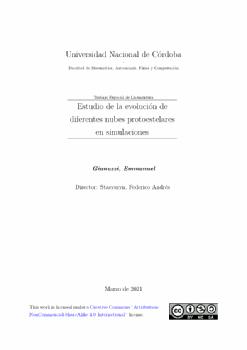| dc.contributor.advisor | Stasyszyn, Federico Andrés | |
| dc.contributor.author | Gianuzzi, Emmanuel | |
| dc.date.accessioned | 2021-04-16T15:09:34Z | |
| dc.date.available | 2021-04-16T15:09:34Z | |
| dc.date.issued | 2021-03 | |
| dc.identifier.uri | http://hdl.handle.net/11086/17722 | |
| dc.description | Tesis (Lic. en Astronomía)--Universidad Nacional de Córdoba, Facultad de Matemática, Astronomía, Física y Computación, 2021. | es |
| dc.description.abstract | El proceso de formación estelar es aún uno de los principales problemas sin resolver de la astrofísica moderna. A pesar de que el conocimiento acerca de este proceso fundamental, conectado a las áreas de formación galáctica, ciencia planetaria y la evolución estelar, se ha modificado y ampliado notablemente en las últimas décadas gracias a las nuevas observaciones y a los avances teóricos, aún quedan muchas incógnitas por responder. Con el fin de brindar información sobre este proceso, en este trabajo se realizaron simulaciones numéricas SPH de la evolución de nueve nube protoestelares, creadas con el código TURBULENT-CLOUD, variando el índice del espectro de potencias en velocidades inicial, la magnitud de la energía cinética inicial, y el modelo ecuación de estado. Todas las nubes poseen el mismo radio, masa, cantidad de partículas, temperatura, y perfil radial de densidad inicial; y logran formar partículas sink al evolucionar. Se realizaron comparaciones entre simulaciones sobre distintas propiedades tales como la evolución de su espectro de potencias, energía y multiplicidad de sistemas formados. | es |
| dc.description.abstract | The process of star formation is still one of the main unsolved problems of modern astrophysics. Although the knowledge about this fundamental process, connected to the areas of galactic formation, planetary science and stellar evolution, has been significantly modified and extended in the last decades thanks to new observations and theoretical advances, there are still many unknowns to be answered. In order to provide information about this process, in this work we performed SPH numerical simulations of the evolution of nine protostellar clouds, created with the TURBULENT-CLOUD code, varying the index of the power spectrum in initial velocities, the magnitude of the initial kinetic energy, and the model equation of state. All clouds have the same radius, mass, number of particles, temperature, and initial radial density profile; and they manage to form sink particles as they evolve. Comparisons were made between simulations on different properties such as the evolution of their power spectrum, energy and multiplicity of formed systems. | en |
| dc.language.iso | spa | es |
| dc.rights | Atribución-NoComercial-CompartirIgual 4.0 Internacional | * |
| dc.rights.uri | http://creativecommons.org/licenses/by-nc-sa/4.0/ | * |
| dc.subject | Formación estelar | es |
| dc.subject | Simulaciones numéricas | es |
| dc.subject | Nubes moleculares | es |
| dc.subject | Partículas sumidero | es |
| dc.subject | Astrophysical and cosmological simulations | en |
| dc.subject | SPH | en |
| dc.subject | Turbulent cloud | en |
| dc.title | Estudio de la evolución de diferentes nubes protoestelares en simulaciones | es |
| dc.type | bachelorThesis | es |
| dc.description.fil | Fil: Gianuzzi, Emmanuel. Universidad Nacional de Córdoba. Facultad de Matemática, Astronomía, Física y Computación; Argentina. | es |





